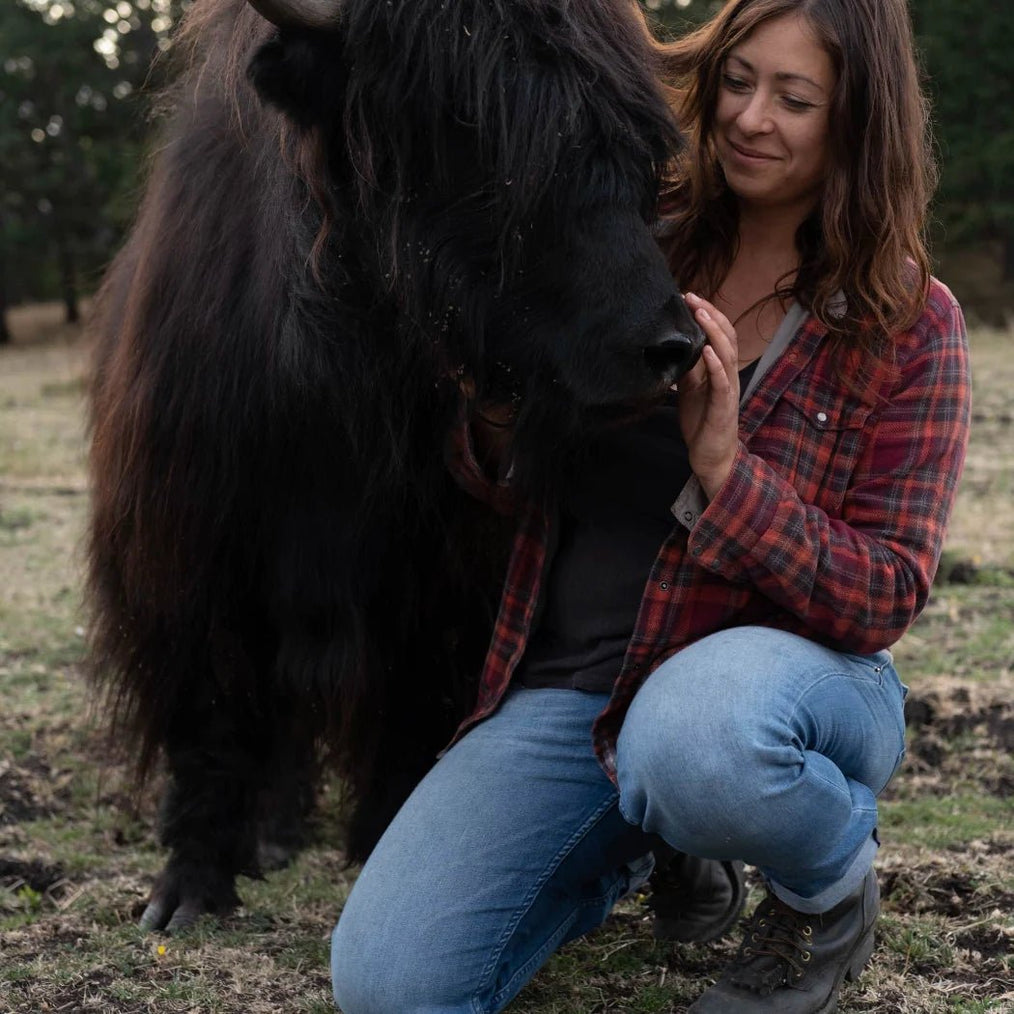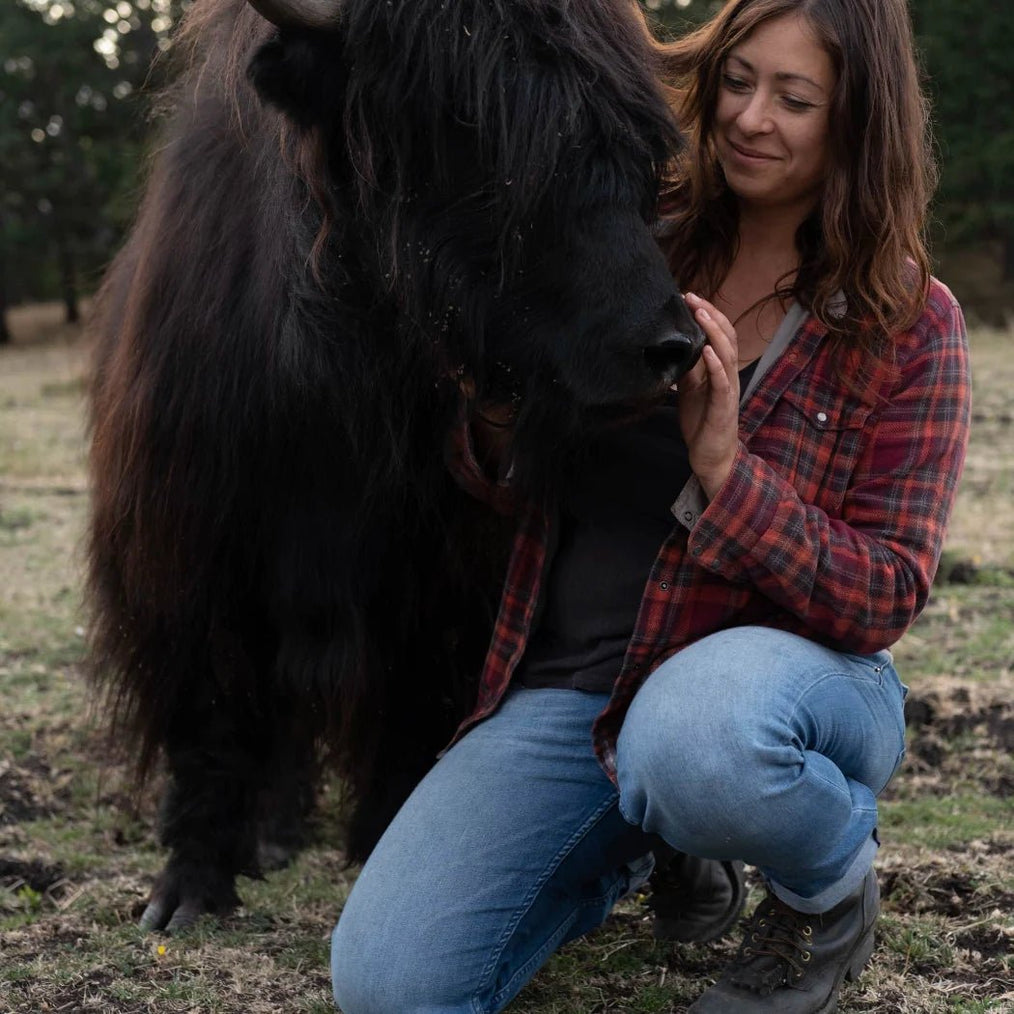Classification & Description
Domestic yak are bovid animals in the family Bovidae. Yak belong to the genus Bos and species grunniens. They differ from the vulnerable population of wild yak, Bos mutus which currently exist in a small region above 14,000 feet in the Tibetan Plateau. Comparatively, common domestic cattle are classified as Bos taurus. Yak are also known as the “Grunting Ox” due to the low grunting sounds they make when communicating or excited. They are otherwise silent.
Yak are characterized by their large horns, shoulder hump, horse-like tail and full coat of dense fiber. Bulls with ample fiber have a “skirt" that sways as they walk. Females typically weigh between 500-800 pounds and bulls can weigh up to 1900 pounds. Their size is determined by both genetics and quality/quantity of feed. Yak have a layered coat with cashmere-like down underneath and long thicker guard hairs over the entire body.
There are multiple phenotypes of yak and they can vary in appearance. Some have longer, more “horse-like” faces and little to no hair on the forehead. Others have shorter, boxy shaped heads. Some have an immense amount of hair. These long haired animals are called hairy forehead yak in Tibet, and super woolies in the US. Breeders may have different preferences, but there are general conformation, size, and temperament standards that determine an animal’s value.
Fossil records indicate that domestic yak developed over 4,500 years ago in a large area of the Qinghai-Tibetan Plateau, commonly known as the “Roof of the World”. It is believed that without yak, the Tibetan Plateau could not have been colonized by humans. Over the centuries, their domestication spread to regions including Mongolia, Russia, India, Nepal, Bhutan, and Pakistan. Currently their populations are 14.2 million, with 13.3 in the Tibetan Plateau, 600,000 in Mongolia and the remaining 300,000 in other regions of the world. DOMESTICATION AND DISTRIBUTION OF YAK
Yak are still used in remote areas for packing, riding, milk, meat, shelter, clothing, tools, and accessories. Yak dairy products are a major form of sustenance for people in the Tibetan/Himalayan region. Their fiber is used to make tents, outerwear, ropes, clothing, and bags. Meat and dairy are often dried for preservation. With the rise of globalization and the increase of young people moving to urban areas, traditional lifestyles with yaks are on the decline. However, yak fiber is becoming internationally popular and increased demand may help promote the lifestyle of traditional nomadic peoples.
It has been generally thought that domestic yak evolved through breeding wild yak with Asiatic cattle breeds. This, however, may be untrue. While it is common to breed yak with cattle to create hybrids, the species was most likely developed through humans domesticating wild yak millenia ago. The offspring of yak and cattle crosses in Tibet are called “dzo” for males and “dzomo” for females. These animals serve a very specific purpose in their native regions, but hybrids are not reintroduced into the yak population for breeding purposes.
Hardiness & efficiency
In their native region they provide transportation and packing, fiber, milk and meat. They are fully equipped to deal with adverse weather using their compact size and down undercoat which grow and shed seasonally. Yak are intelligent, alert and calm, with excellent eyesight and hearing. Their only natural predator is the Tibetan Wolf. It is ingrained in their being to have a great dislike for dogs.
They have less impact on the land than cattle with smaller feet and more efficient nutrient absorption, eating about one-third of a cow’s daily consumption. Many ranchers use a 2 to 1 stocking rate to cattle. Their manure makes excellent fertilizer for crops.
Even though yak can survive on the sparse Tibetan Plateau, we like to keep them happy on organic grass/alfalfa and mountain pastures. A good feeding program makes for beautiful, healthy animals.

Yak in the US
Yak arrived in the United States via Canada in the early 1900’s. The entire population began with around 20 yak. Currently there is no importation of live animals or fluids into the United States. Therefore, focused breeding programs are of key importance to maintain genetic diversity.
Yak began to gain popularity in the 1980’s when ranchers increasingly began breeding programs. The population in the North America is currently estimated to be around 7,000 to 10,000 animals. The popularity of yak meat is on the rise, as is the demand for yak fiber. Each year new breeders begin herds on farms and ranches across the US and Canada. However, yak are less tolerant of heat and humidity and perform best in regions with seasonality.
Temperaments and characteristics of yak vary wildly, just as in a human population. Over the decades, many breeders have retained the traits that both produce well and are docile, tractable animals. The main way in which this is accomplished is “line breeding”. For those unfamiliar to the term, it is a form of controlled in-breeding, where animals are bred back to the same genetic line skipping at least one generation, maintaining and promoting certain traits.
Because the genetic base in the US is so limited, we are focusing our efforts here towards ensuring we have a wide variety of genetics to select and breed from to in order to best promote the resilience of the species. This also provides genetic outcross options for long standing, established bloodlines.
Here is a well researched article on how yak arrived in the US.



